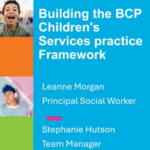
Social workers could more than double the time they spend with children and families through more efficient case management systems and fewer meetings.
That was the conclusion from a report last week from county council leaders setting out a “blueprint” designed to keep more children with their families through relationship and strengths-based practice.
Practitioners’ studies typically spent just under 20% of their time working directly with children and families, found the paper by the County Councils Network (CCN), Association of County Chief Executives (ACCE) and consultancy Newton.
Half of social worker time spent on admin
By contrast, they spent half of their time on case recording, administration or other IT tasks, and significant time in meetings.
Researchers based their estimates on more than 100 social workers logging their time over the course of a week, and through shadowing some practitioners to observe how they split their time.
The report said practitioners’ time with children and families could rise to 45% on average if councils invested in digital systems that supported more efficient case recording, limited internal meetings and expanded the use of remote meetings developed through the Covid-19 pandemic.
The call came as a British Association of Social Workers report released in the same week found that the demands of administrative tasks was the biggest challenge practitioners reported facing in their roles.
Projected care population ‘could be cut by a third’
The CCN, ACCE and Newton report projected that the number of children in care in England could rise from 80,850 to between 86,000 and 95,000 by the end of 2025, adding up to £2.1bn to costs. This meant “the status quo was not an option”, it said
However, the report estimated that reforms could save 95% of the cost and cut by a third the projected number of children looked after by 2025 to between 64,000 and 77,000.
Based on case reviews with practitioners, the report estimated that 39% of children currently looked after could have avoided coming into care had the system worked differently and there was more support in place for families on the verge of crisis.
It recommended that councils spend £205m a year on ‘edge of care’ services to support those young people either at risk of coming into care or who could return to their families where it was safe to do so.
This would involve practitioners having the time to build and maintain strong and trusting relationships with families, working effectively with adults’ specialists and other agencies in a whole-family way and building on families’ strengths to overcome challenges.
Related articles
Reforms ‘cannot be done on a shoestring’
The report, based on analysis of six county authorities, national data sets and conversations with more than 200 people in the system, also called for investment in care provision to provide more support in family-based settings rather than residential care.
It estimated that 40% fewer children (between 3,300 and 4,400) could be in children’s homes and placed with kinship or foster carers instead, including through improved foster carer recruitment and support.
Keith Glazier, children’s services spokesperson for the CCN, said: “The report throws down the gauntlet for local authorities to work more effectively, but it also shows how the rest of the public sector can be more joined up in supporting families on the verge of crisis, and in delivering meaningful support to reduce the need for lengthy periods in care: improving outcomes for children.
“However, this cannot be done on a shoestring and we urge for a substantial injection of funding from government this year so we can begin to transform services.
‘Social work at its best is face-to-face’
BASW said the report chimed with its own 80-20 campaign, which aims to reduce bureaucracy and increase support and resources so social workers spend more with families.
“Social work at its best happens face to face and that’s what social workers want to do, not be stuck doing admin,” it said.
The Association of Directors of Children’s Services agreed with the report’s recommendations of a long-term funding settlement for children’s services, a greater focus on early help and prevention and a national focus on recruiting and retaining foster carers.
“Although care can be the right thing for some children, we should be doing all we can to support families to stay together safely, in line with the Children Act 1989,” said ADCS president Charlotte Ramsden.
“Government should support us in this by ensuring we have appropriate resources to keep children safe from harm and to provide targeted early help at the earliest opportunity.”
The Department for Education (DfE) said it recognised the “pressures that councils are facing on children’s services” and that some of the £4.8bn increase in government grant funding for councils over the next three years announced at last year’s spending review would go towards addressing this.
“This support comes alongside wider investment in children and family services, including our expansion and rollout of family hubs across the country and through the supported families programme,” a spokesperson for the department said.
They added that the care review, due to be published in late spring, would “provide an opportunity to reform the care system more widely”.





 Bournemouth, Christchurch and Poole
Bournemouth, Christchurch and Poole  Hampshire County Council
Hampshire County Council  Oxfordshire County Council
Oxfordshire County Council  South Gloucestershire Council
South Gloucestershire Council  Wokingham Borough Council
Wokingham Borough Council  Webinar: building a practice framework with the influence of practitioner voice
Webinar: building a practice framework with the influence of practitioner voice  ‘They don’t have to retell their story’: building long-lasting relationships with children and young people
‘They don’t have to retell their story’: building long-lasting relationships with children and young people  Podcast: returning to social work after becoming a first-time parent
Podcast: returning to social work after becoming a first-time parent  How managers are inspiring social workers to progress in their careers
How managers are inspiring social workers to progress in their careers  Workforce Insights – showcasing a selection of the sector’s top recruiters
Workforce Insights – showcasing a selection of the sector’s top recruiters 

 Facebook
Facebook X
X LinkedIn
LinkedIn Instagram
Instagram
Childcare social work is a hugely complex task because of both legislative and practice demands correspondingly the IT systems that support that have to be able to reflect this complexity. When I qualified pre children act I had extensive Admin support and spent significantly more time with service users.
The reduction in Admin support because of the introduction of computer systems that were sold as intuitively easy and efficient for practitioners to use has never materialised and was never supported by any research or evidence. This has been made much worse by the low level of investment in IT systems which is apparent when you compare both the hardware and software I use compared with that of other professionals.
Will this be the beginning of the end of social work by phone call? Asking as I have been told to cancel a visit as my “data” risks breaching a KPI target and needs to be updated today. The breach? Not completing an e-training module which actually has a deadline in April. Breach? None but the system counts “uncompleted” assessments by month rather than due date so……Tried to explain but response is the AD wants it done today. This is replicated across all services so actually who are we here for? Is there a more inappropriate description of mundane stupidity than Key Performance Indicator?
I think this takes more than efficient IT systems but a cultural shift which is willing to move away from having to record everything that is said and done, that values direct work produced with a child or family, and moves away from excessive report writing, minutes etc. Many of oyr working documents could be drastically slim lined.